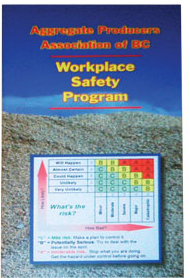
Features
Columns
Education
Workplace Safety Program
A new program by the Aggregate Producers Association of BC aims at making the aggregates business
February 10, 2011 By Paul Allard and Brian Weeks
Based on WorkSafe BC statistics the Aggregate Producers Association of
BC (APABC), had always believed that the aggregate industry was one of
the safest heavy industries in the province.
Based on WorkSafe BC statistics the Aggregate Producers Association of BC (APABC), had always believed that the aggregate industry was one of the safest heavy industries in the province. Then 2007 happened. Four aggregate industry workers lost their lives through preventable accidents in less than eight months. Clearly, something was very wrong with the safety culture in our business.
 |
|
| The Infoflip pocket manual will eventually be distributed to every worker in B.C.’s aggregate industry.
|
The provincial Ministry of Mines summoned the APABC to Victoria to discuss these tragic events and, more importantly, to discuss how to prevent a reoccurrence. The outcome was the creation of the “Aggregate Safety Committee”– a tripartite group composed of the APABC, the Ministry of Energy, Mines and Petroleum Resources (MEMPR) and the Construction Safety Network (CSN). The new committee was tasked with developing and distributing an educational program to refresh and upgrade safety awareness among all aggregate producers in B.C. within one year.
Step one was to research the scope of the problem to identify primary accident causes. We quickly found out that our aggregate industry was not as safe as we believed. We had been relying on the entire Mining industry’s safety records when we should have been focusing on aggregate production alone. In fact, aggregate production in BC had an accident rate almost four times greater than that of the entire mining industry. Unfortunately, we also learned that the statistics collected by WorkSafe BC were not well suited to the causal analysis we had hoped to do.
We then decided that to rely upon user data to identify common aggregate production tasks and their related hazards. As a step two, we surveyed our members and used their input to establish more than 175 job tasks that take place on any given day during the production of aggregate. With the job tasks identified, step three was to rank these tasks as to their risks and develop strategies to mitigate the potential for accidents associated with each risk.
Step four identified key knowledge and skills required to implement these safety strategies. Step five was the development of the templates for creation of safety manuals and a list of best practices relating to the high-risk tasks.
There were four outcomes of the project: 1) a website containing templates to enable producers to create a customized safety manual for each of their sites; 2) a pocket sized “Info-Flip” suitable for every worker to use to evaluate and minimize risks involved in common industry tasks (Photo above); 3) a USB memory stick containing relevant information with links to the website; and (4) a half day training workshop to learn how to use these new tools.
The fourth quarter of the allotted year was dedicated to delivering the workshop to as many companies and individuals as possible. In total, six workshops have been conducted since 2008. Both large and small businesses participated, as well as MEMPR representatives who provided positive feedback on the workshop’s presentation. In total, we have presented the Workplace Safety Program to 135 individuals from both the private and public sectors.
Currently the Workplace Safety Program is on hold as it undergoes review for enhancement.
We recently finished a feasibility study to determine the cost of converting the existing workshop curriculum into an on-line program focusing on Hazard Identification and Control and Accident Investigation. We expect the transition to an on-line format will allow us to bring the training to aggregate producers and workers everywhere in a more convenient way. We anticipate approval for the conversion to be considered in February 2011. If approved, development and implementation of the on-line training programs will be completed and launched this year.
Meanwhile, users can go to the current on-line safety tool, have a tour of the project and provide us with feedback. Just click on http://wsp.safetynetwork.bc.ca/index.cfm?CFID=72285&CFTOKEN=86864132 .
The Workplace Safety Program remains a “Living Document” that is intended to be adapted to refine and modify risky tasks as new circumstances and hardware that affect those tasks evolve. The input from our industry associates across the country will be very important to the improvement of the online content. We encourage you to try it out and send in your comments.
To acquire future productions of the InfoFlip or memory sticks, please contact Paul Allard – Executive Director at the APABC (gravelbc@telus.net). The costs will be around $20.00 for each item.
Allard is the Executive Director of the APABC. Brian Weeks is with Mainland Sand & Gravel Ltd.
Print this page